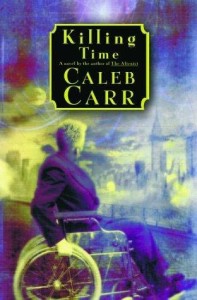Included below is a summary of Caleb Carr’s fourth work of fiction, Killing Time, which was originally written as a serial for Time magazine in 1999 and subsequently published by Random House in 2000. Selected critical reception has also been included. For summaries and selected critical reception of Caleb Carr’s other fiction and non-fiction works, please use the menu.
Killing Time Summary
Publisher’s Blurb
Meet Dr. Gideon Wolfe, expert criminologist of the new millennium. A professor at New York’s John Jay University in the year 2023, he lives in an era that has seen plague, a global economic crash, and the 2018 assassination of President Emily Forrester. In this turbulent new world order, Wolfe’s life and everything he knows are turned upside down when the widow of a murdered special-effects wizard enters his office.
The widow hands him a silver disc from her husband’s safety deposit box, hoping that Wolfe’s expertise in history and criminology will compel him to track down her husband’s killers. The disc contains footage of President Forrester’s assassination, the same video that has been broadcast countless times on TV and over the internet-with one crucial, shocking difference: This version shows that before the video was released, it was altered with sinister special effects.
This explosive discovery will lead Gideon Wolfe on an electrifying journey from a criminal underworld of New York to the jungles of Africa and on a quest to find the truth in an age when all information can be manipulated. With this novel, Carr has boldly established a new genre-future history-combining the best elements of mystery and thrillers with unique historical insight. Breathtakingly suspenseful, Killing Time unfolds as the work of a master novelist.
Killing Time Critical Reception
Carr’s future is suffused with regret. It’s also rife with mystery and suspense; in every chapter the stakes are raised a little higher, the apocalypse hovers a little closer. This author is a master of the cliffhanger, of cryptic warnings that return to haunt our hero later in the text. Occasional flashes of humor relieve the prevailing ominousness, and a beautiful girl with a huge gun appears at regular intervals to keep things humming. Fans of Steve Erickson’s end-of-the-world novels will likely enjoy this adventure in the Internet age, where the sheer amount of information has induced not quantitative changes in the human psyche, but qualitative ones.
After proving his prowess with two best-selling historical thrillers, “The Alienist” and “The Angel of Darkness,” Carr presents a trippy, provocative tale set in the not-too-distant future, with a world undone by too much information and too little truth … Overall, he’s not quite as sure-footed with Orwellian science fiction as with his historical novels, but “Killing Time” is more frightening since it is set less than a quarter-century from our own fitful times.
Killing Time is a worthwhile read. His style is faintly reminiscent of H. G. Wells or Jules Verne, which, given the political tone and the ultimate socialist slant of the work, is quite appropriate. What is most important here, however, is that, as with all literature that aspires to greatness, Killing Time gets the reader thinking. And this, despite whatever other shortcomings it may have, is its ultimate worth.
Carr’s bizarre cautionary tale, subtitled “A Novel of the Future” (and reminiscent of both H.G. Wells’s tough-minded speculative romances and Jack London at his most engagingly deranged), examines the consequences of information overload and “image manipulation” in a craven new world in which two percent of the US population is in prison, the Balkans have re-erupted, and an ongoing war between India and Pakistan complicates international diplomacy and threatens the global community’s stability, if not its survival … Fun, but awfully sketchy. Carr seems more at home in the past than in the future.
SFX Magazine:
Killing Time is a convincing and well-written look into an all too plausible future.

